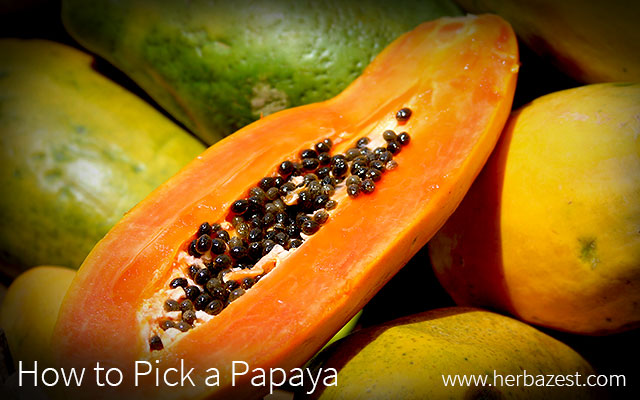Papaya nutrition includes rich stores of vitamins and other essential compounds which, along with its creamy, melon-like flavor, make of this tropical crop a staple food around the world.
Having sparked a growing consumer interest worldwide, the elusive fruit has many people asking themselves how to choose a papaya that speaks to their individual needs. The most important deciding factors are price, availability, degree of ripeness, and intended use.
Papaya: Pick the Best One for You
Picking a great papaya is not supposed to be complicated; however, the following considerations can help guide even the most indecisive fruit lovers:
Availability. Because some major producers have reported significant losses in fruit yield due to unforeseen environmental causes, location plays a huge role in the price and availability of papayas worldwide.
Heat, drought, and cold weather onset are usually the most significant problems, but plant disease may also occur. In such cases papaya supply trails far behind demand, driving spikes in pricing. Papayas are, nevertheless, grown year-round in many areas.
Variety. Many papaya varieties and types of cultivars exist in the world, however the most prevalent come from two main varieties. Sweet, pear-shaped and weighing less than three pounds, Hawaiian 'Solo' cultivars are widely available in supermarkets. On the other hand, with a bit of a mild flavor the Cuban 'Maradol' can weigh up to 10 pounds (4.5 k), and is found in many Latin American markets. It is sold at a lower price per pound, but usually requires a bigger investment because of the sheer size of its fruits.
Use in savory preparations. A green papaya typically shows a dark green skin, suggests that it has been picked from the tree before reaching maturity. These unripe papayas have almost no fruit sugars and are easily cooked and prepared as vegetables, or pickled for use in Asian-inspired salads. Green papayas also have the richest content of latex, and may therefore be used to tenderize tough meats.
Ripeness. Establishing the prevalence of a golden yellow hue on its outer skin is how to choose papaya fruits that are ripe and ready to eat. The flesh will be adequately firm, but with a little give when gently pressed.
While their sweet flavors makes them ideal for consumption as a breakfast or dessert fruits, a ripe papaya makes a great additions to many uncooked dishes, such as a fresh avocado and papaya salad. They can also be sliced and candied, or used to make jams and baked goods.
Texture. Much like establishing its maturity, how to pick a papaya for its texture involves careful observation of its degree of ripeness. For example, a soft, mushy fruit with an overpoweringly sweet smell is considered to be overripe.
This doesn't mean that they are completely unworkable, however: if used quickly overripe papayas blend easily into fruit purees for frozen milkshakes, ice creams, and refreshing beverages, like a delicious camu camu, papaya, and pineapple slushie.
Seed content. It should go without saying that the larger the papaya and the more developed it is, the more seeds it will contain. While there is a type of papaya without seeds, it is good to remember this simple rule of thumb when choosing a papaya whose seeds can be ground into a peppery spice, or planted for home gardening purposes.
How to pick a papaya depends on a number of different factors. While flavor, price, and ripeness are all significant, the best papaya that you can choose is one that has been responsibly grown and cared for.
Sources
- A guide to market fruits of southeast Asia
- International Tropical Fruits Network, Info: Global papaya market overview
- University of Arkansas, Papaya – A strange name but sweet flavor
- University of Tennessee, A guide to buying fresh fruits & vegetables
- University of Wyoming, Nutrition and food safety, Papaya power!




